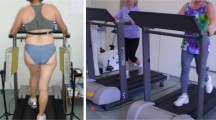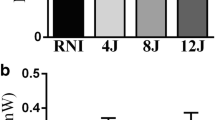Abstract
The aim of this study was to histologically and biochemically analyze the effects of light-emitting diode therapy (LEDT) associated with resistance training to prevent sarcopenia in ovariectomized rats. Forty female Wistar rats (12 months old, 295–330 g) were bilaterally ovariectomized and divided into four groups (n = 10 per group): control–sedentary (C), resistance training (T), LEDT–sedentary (L), and LEDT plus resistance training (LT). Trained rats performed a 12-week water-jumping program (3 days per week) carrying a load equivalent to 50–80 % of their body mass strapped to their back. Depending on the group protocol, the LED device (850 nm, 100 mW, 120 J/cm2, spot size 0.5 cm2) was used either as the only method or after the resistance training had been performed. The device was used in the single point contact mode (for 10 min). The irradiated region was the center of the greater trochanter of the right femur and the middle third of the rectus femoris muscle was subsequently analyzed histomorphometrically. Significant increases (p < 0.05) were noted for the muscle volume of the T (68.1 ± 19.7 %), the L (74.1 ± 5.1 %), and the LT (68.2 ± 11.5 %) groups compared to the C group (60.4 ± 5.5 %). There were also significant increases in the concentrations of IGF-1, IL-1, and TNF-α in the muscles of the treated groups (p < 0.05). Animals in the LT group showed a significant increase in IL-6 compared to T, L, and C groups (p < 0.05). These findings suggest that resistance training and LEDT can prevent sarcopenia in ovariectomized rats.








Similar content being viewed by others
References
Enns DL, Tiidus PM (2008) Estrogen influences satellite cell activation and proliferation following downhill running in rats. J Appl Physiol 104(2):347–353
Goldspink G (2007) Loss of muscle strength during aging studied at the gene level. Rejuvenation Res 10:397–405
Yang J, Anzo M, Cohen P (2005) Control of aging and longevity by IGF-1 signaling. Exp Gerontol 40(11):867–872
de Salles BF, Simão R, Fleck SJ, Dias I, Kraemer-Aguiar LG, Bouskela E (2010) Effects of resistance training on cytokines. Int J Sports Med 31(7):441–450
Adamo ML, Farrar RP (2006) Resistance training and IGF involvement in the maintenance of muscle mass during the aging process. Ageing Res Rev 5(3):310–331
Lee S, Barton ER, Sweeney HL, Farrar RP (2004) Viral expression of insulin-like growth factor-I enhances muscle hypertrophy in resistance-trained rats. J Appl Physiol 96(3):1097–1104
Izquierdo M, Ibañez J, Calbet JA, Navarro-Amezqueta I, González-Izal M, Idoate F, Häkkinen K, Kraemer WJ, Palacios-Sarrasqueta M, Almar M, Gorostiaga EM (2009) Cytokine and hormone responses to resistance training. Eur J Appl Physiol 107:397–409
Yarrow JF, Borsa PA, Borst SE, Sitren HS, Stevens BR, White LJ (2007) Neuroendocrine responses to an acute bout of eccentric-enhanced resistance exercise. Med Sci Sports Exerc 39:941–947
Peterson CM, Johannsen DL, Ravussin E (2012) Skeletal muscle mitochondria and aging: a review. J Aging Res. doi:10.1155/2012/194821
Fulle S, Protasi F, Di Tano G, Pietrangelo T, Beltramin A, Boncompagni S, Vecchiet L, Fanò G (2004) The contribution of reactive oxygen species to sarcopenia and muscle ageing. Exp Gerontol 39(1):17–24
Sakuma K, Yamaguchi A (2010) Molecular mechanisms in aging and current strategies to counteract sarcopenia. Curr Aging Sci 3(2):90–101
Cheung K, Hume P, Maxwell L (2003) Delayed onset muscle soreness: treatment strategies and performance factors. Sports Med 33(2):145–164
Leal Junior EC, Lopes-Martins RA, Baroni BM, De Marchi T, Rossi RP, Grosselli D, Generosi RA, de Godoi V, Basso M, Mancalossi JL, Bjordal JM (2009) Comparison between single-diode low-level laser therapy (LLLT) and LED multi-diode (cluster) therapy (LEDT) applications before high-intensity exercise. Photomed Laser Surg 27(4):617–623
Karu TI, Piatybrat LV, Afanasyeva NI (2004) A novel mitochondrial signaling pathway activated by visible to-near infrared radiation. Photochem Photobiol 80(2):366–372
De Marchi T, Leal Junior EC, Bortoli C, Tomazoni SS, Lopes-Martins RA, Salvador M (2012) Low-level laser therapy (LLLT) in human progressive-intensity running: effects on exercise performance, skeletal muscle status, and oxidative stress. Lasers Med Sci 27(1):231–236
Reddy GK (2004) Photobiological basis and clinical role of low-intensity lasers in biology and medicine. J Clin Laser Med Surg 22(2):141–150
Servetto N, Cremonezzi D, Simes JC, Moya M, Soriano F, Palma JA, Campana VR (2010) Evaluation of inflammatory biomarkers associated with oxidative stress and histological assessment of low-level laser therapy in experimental myopathy. Lasers Surg Med 42(6):577–583
Mesquita-Ferrari RA, Martins MD, Silva JA Jr, da Silva TD, Piovesan RF, Pavesi VC, Bussadori SK, Fernandes KP (2011) Effects of low-level laser therapy on expression of TNF-α and TGF-β in skeletal muscle during the repair process. Lasers Med Sci 26(3):335–340
Luo L, Sun Z, Zhang L, Li X, Dong Y, Liu TC (2012) Effects of low-level laser therapy on ROS homeostasis and expression of IGF-1 and TGF-β1 in skeletal muscle during the repair process. Lasers Med Sci. doi:10.10007/s10103-0/2-1133-0
Nakano J, Kataoka H, Sakamoto J, Origuchi T, Okita M, Yoshimura T (2009) Low-level laser irradiation promotes the recovery of atrophied gastrocnemius skeletal muscle in rats. Exp Physiol 94(9):1005–1015
Corazza AV, Jacks J, Kurachi C, Bagnato VS (2007) Photobiomodulation on the angiogenesis of skin wounds in rats using different light sources. Photomed Laser Surg 25(2):102–106
Paolillo FR, Corazza AV, Borghi-Silva A, Parizotto NA, Kurachi C, Bagnato VS (2012) Infrared LED irradiation applied during high-intensity treadmill training improves maximal exercise tolerance in postmenopausal women: a 6-month longitudinal study. Lasers Med Sci. doi:10.1007/s10103-012-1062-y
DaCosta RS, Andersson H, Wilson BC (2003) Molecular fluorescence excitation–emission matrices relevant to tissue spectroscopy. Photochem Photobiol 78:384–392
Whelan HT, Buchmann EV, Dhokalia A, Kane MP, Whelan NT, Wong-Riley MT, Eells JT, Gould LJ, Hammamieh R, Das R, Jett M (2003) Effect of NASA light-emitting diode irradiation on molecular changes for wound healing in diabetic mice. J Clin Laser Med Surg 21(2):67–74
Sussai DA, Carvalho Pde T, Dourado DM, Belchior AC, dos Reis FA, Pereira DM (2010) Low-level laser therapy attenuates creatine kinase levels and apoptosis during forced swimming in rats. Lasers Med Sci 25(1):115–120
Cunha TS, Tanno AP, Moura MJCS, Marcondes FK (2005) Influence of high-intensity exercise training and anabolic steroid treatment on rat tissue glycogen contents. Life Sci 77(9):1030–1043
Hornberger TA, Farrar RP (2004) Physiological hypertrophy of the FHL muscle following 8 weeks of progressive resistance exercise in the rat. Can J Appl Physiol 29(1):16–31
Weibel ER, Kistler GS, Scherle WF (1966) Practical stereological methods for morphometric cytology. J Cell Biol 30(1):23–38
Phillips T, Leeuwenburgh C (2005) Muscle fiber specific apoptosis and TNF-α signaling in sarcopenia are attenuated by life-long calorie restriction. FASEB J 19(6):668–670
Ferraresi C, de Brito Oliveira T, de Oliveira Zafalon L, de Menezes Reiff RB, Baldissera V, de Andrade Perez SE, Matheucci Júnior E, Parizotto NA (2011) Effects of low level laser therapy (808 nm) on physical strength training in humans. Lasers Med Sci 26(3):349–358
Smith C, Kruger MJ, Smith RM, Myburgh KH (2008) The inflammatory response to skeletal muscle injury: illuminating complexities. Sports Med 38(11):947–969
Wu S, Xing D, Wang F, Chen T, Chen WR (2007) Mechanistic study of apoptosis induced by high-fluence low-power laser irradiation using fluorescence imaging techniques. J Biomed Opt 12(6):064015
Huang YY, Chen AC, Carroll JD, Hamblin MR (2011) Biphasic dose response in low-level light therapy—an update. Dose-Response 9(4):602–618
Tunér J, Hode L (2002) Laser therapy—clinical practice and scientific background. UP Print, Tallinn, 571
Pöntinen PJ (2000) Laser acupuncture. In: Simunovic Z (ed) Lasers in medicine and dentistry: basic and up-to-date clinical application of low-energy-level laser therapy (LLLT). Vitgraf, Rijeka, pp 455–475
Lakyová L, Toporcer T, Tomečková V, Sabo J, Radoňak J (2010) Low-level laser therapy for protection against skeletal muscle damage after ischemia–reperfusion injury in rat hind limbs. Lasers Surg Med 42(9):665–672
Saygun I, Karacay S, Serdar M, Ural AU, Sencimen M, Kurtis B (2008) Effects of laser irradiation on the release of basic fibroblast growth factor (bFGF), insulin like growth factor-1 (IGF-1), and receptor of IGF-1 (IGFBP3) from gingival fibroblasts. Lasers Med Sci 23(2):211–215
Oron U (2006) Photoengineering of tissue repair in skeletal and cardiac muscles. Photomed Laser Surg 24(2):111–120
Karagounis LG, Yaspelkis BB III, Reeder DW, Lancaster GI, Hawley JA, Coffey VG (2010) Contraction-induced changes in TNF-α and Akt-mediated signalling are associated with increased myofibrillar protein in rat skeletal muscle. Eur J Appl Physiol 109(5):839–848
de Souza RWA, Aguiar AF, Carani FR, Campos GER, Padovani CR, Silva MDP (2011) High-intensity resistance training with insufficient recovery time between bouts induce atrophy and alterations in myosin heavy chain content in rat skeletal muscle. Anat Rec (Hoboken) 294(8):1393–1400
Seene T, Kaasik P, Alev K, Pehme A, Riso EM (2004) Composition and turnover of contractile proteins in volume-overtrained skeletal muscle. Int J Sports Med 25(6):438–445
Forbes SC, Little JP, Candow DG (2012) Exercise and nutritional interventions for improving aging muscle health. Endocrine 42(1):29–38
Petersen AMW, Pedersen BK (2005) The anti-inflammatory effect of exercise. J Appl Physiol 98(4):1154–1162
Stitt TN, Drujan D, Clarke BA, Panaro F, Timofeyva Y, Kline WO, Gonzalez M, Yancopoulos GD, Glass DJ (2004) The IGF-1/PI3K/Akt pathway prevents expression of muscle atrophy-induced ubiquitin ligases by inhibiting FOXO transcription factors. Mol Cell 14(3):395–403
Suetta C, Clemmensen C, Andersen JL, Magnusson SP, Schjerling P, Kjaer M (2010) Coordinated increase in skeletal muscle fiber area and expression of IGF-I with resistance exercise in elderly post-operative patients. Growth Horm IGF Res 20(2):134–140
Acknowledgments
The authors would like to thank Felippe Furlan, Júlio César Domingues, Luis Vaz de Lima Júnior, and Mariana Sabino Bortolozzo for valuable technical assistance. We would also like to thank the Conselho Nacional de Desenvolvimento Científico e Tecnológico (CNPq) for their financial support.
Author information
Authors and Affiliations
Corresponding author
Rights and permissions
About this article
Cite this article
Corazza, A.V., Paolillo, F.R., Groppo, F.C. et al. Phototherapy and resistance training prevent sarcopenia in ovariectomized rats. Lasers Med Sci 28, 1467–1474 (2013). https://doi.org/10.1007/s10103-012-1251-8
Received:
Accepted:
Published:
Issue Date:
DOI: https://doi.org/10.1007/s10103-012-1251-8




